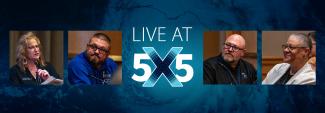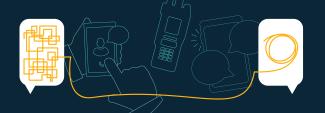Summary
The Public Safety Immersive Test Center is a state-of-the-art facility designed to provide responders, researchers, and developers a virtual environment to develop, test, and evaluate public safety technologies. FirstNet Authority Chief Network Technology Officer Jeff Bratcher and Public Safety Communications Research (PSCR) Division Chief Dereck Orr discuss the launch of the Test Center and the history of partnership between the FirstNet Authority and PSCR.
Guest
Jeff Bratcher
FirstNet Authority Chief Network and Technology Officer
Dereck Orr
Division Chief, National Institute of Standards and Technology Public Safety Communications Research Division
Transcript
Preview
Narrator: You're listening to Public Safety First, a podcast to help you learn about the First Responder Network Authority and how you can be part of the future of public safety technology.
And now, your host.
Jeff Bratcher: Hello. Welcome to the Public Safety First Podcast. My name is Jeff Bratcher and I'm the Chief Network and Technology Officer for the First Responder Network Authority based here in Boulder, Colorado, at our technical headquarters. Today, I'm honored to be joined by my colleague and close friend, Dereck Orr.
Narrator: You're listening to Public Safety First, a podcast to help you learn about the First Responder Network Authority and how you can be part of the future of public safety technology.
And now, your host.
Jeff Bratcher: Hello. Welcome to the Public Safety First Podcast. My name is Jeff Bratcher and I'm the Chief Network and Technology Officer for the First Responder Network Authority based here in Boulder, Colorado, at our technical headquarters. Today, I'm honored to be joined by my colleague and close friend, Dereck Orr.
Dereck joined the National Institute of Standards and Technology [NIST] Public Safety Communications Research [PSCR] Division as a program manager back in 2002. In the 20 years since, he has risen to the role of Division Chief, where he is responsible for leading our nation's primary federal laboratory dedicated to research and development, testing, and evaluation of public safety communications technologies. On a personal note, I started in this space in 2003, so I had the pleasure of knowing Dereck almost as long as he's been working in this space, and I appreciate everything he's done.
Under Dereck's leadership, PSCR has led research in critical areas, including land mobile radio to long term evolution, mission critical services, location-based services, and public safety analytics. His team has also stood up prize challenges to drive innovation in the public safety marketplace. They have doled out grant funding and built programs to help transition technologies from pure research and development to commercialization. We're so honored to have you on the podcast today, Dereck. Thank you for joining.
Dereck Orr: It is a pleasure to be here. And I love that it’s you and I doing this podcast. Jeff, we've had a long journey together and all of the things that you listed out as being successes of mine are successes of ours, you've been a part of the whole thing, and the fact that we've been able to create such a cohesive and important collaborative relationship between our organizations is one of the most satisfying outcomes of my career. So, I'm just happy to be here.
Jeff Bratcher: Thanks, Dereck. Let's actually start with the PSCR program. I gave a quick overview, but I only touched the surface of the work your team does. Can you tell us a little bit more about PSCR, the work you perform, and the team you've built?
Dereck Orr: Sure, absolutely. So, like you said, PSCR has been around for two decades now, in one form or another. And our whole mission from day one until today has always been fairly simple, which is to serve as an objective technical advisor for public safety in the area of communications research, because oftentimes public safety just doesn't have access to the scientific and engineering expertise and test facilities necessary to understand how new technologies and legacy technologies impact their mission critical work. So, our job has been to serve them as their experts, help them understand their requirements, help them take those requirements and turn them into technical definitions, help them take those technical requirements and the standards bodies and turn them into actual documentary standards and have those standards actually find their way into equipment so that public safety gets interoperable, standardized equipment that meets their specific requirements, and then have a place for them to bring that equipment and test it to ensure that it meets the standards that have been set and understand where gaps might still exist. That's our job. And it started out with land mobile radio back after 9/11, focused on interoperability. And today, we're focused on future technologies like heads up displays and location-based services inside of buildings and three-dimensional holograms. But at the core of it, it's still ensuring that this technology is made available to public safety, that it always meets their needs, and that they can feel confident that somebody is there to help them understand both its capabilities and its gaps.
Jeff Bratcher: Great. Thanks. Ten years ago, Congress passed the legislation that created the FirstNet Authority and set us on the path to building the Nationwide Public Safety Broadband Network. That same legislation also provided $300 million in funding for NIST PSCR to perform critical public safety communications research and development focused in that broadband communication space over the span of ten years. So, Dereck, can you share a few of the highlights from the last decade and why this work has been critical to advances in public safety communications? And what do you see going forward beyond this?
Dereck Orr: Absolutely. So, yeah, what you lay out was a once-in-a-lifetime experience for us, which was to have the same legislation that created and funded FirstNet to have $300 million injected into the public safety research and development space. That is a sum of money that eclipses anything that we've seen in the past that has been specific to public safety state and local communications. So, that was incredibly exciting and a great honor for us to be given that responsibility.
We reached out immediately to FirstNet, and the newly created Board and CEO to say, "We want you involved in helping us establish what our priorities are going to be and what our focus areas are going to be." But we also gathered other federal agencies, stakeholders from public safety, academia, industry, and we started a almost four-year period of developing roadmaps that would lead us down a path of focusing on very specific technical areas that everyone identified as being the most impactful on public safety if we were successful in this R&D area.
So, we finally got our funding in 2016. By the end of 2017, we were ready to go, and we recognized that the funding ends September 30th, 2022. And we knew we weren't going to be able to do this all alone. So, we created a program that built off the core value and capabilities of NIST by bringing about 100 researchers from across NIST to bear their specific focus areas and expertise on the problems of public safety that were identified. However, we also knew there was an opportunity to bring on a lot of other experts into this field. And therefore, we created a comprehensive grant program that we have now issued, we're nearing $90 million to over 207 recipients worldwide that are now invested and focused on public safety communications across the areas that we're working on.
We also created a prize challenge program that was very unique to NIST and is fairly unique to the government in general. It was based off of the models like DARPA [Defense Advanced Research Projects Agency] and NASA. And we are in the midst of running 18 prize challenge programs. We've given out almost $7 million in prize challenge awards to almost 215 teams. And they've developed almost 237 prototypes throughout all of these prize challenges. That's a pretty impressive number of people coming up with potential solutions.
And so, we've seen this injection of interest. We've seen academic programs created around these grants to teach students about public safety's needs. We've seen businesses created. We've seen venture capital firms invest in these companies that have been developed through these prize challenges and grants. And we are working through a series of programs based on commercialization to help these innovators take their ideas and actually get them into the hands of first responders. So, we've created a very diverse set of solvers, government experts, scientists, as well as these companies and academics and just interested parties out across the world to really focus on public safety. And when it's all said and done and that money expires, I think we will have left behind not only some great ideas, some new products and companies trying to get these ideas into the hands of public safety, but we will have left behind this entire new generation of researchers and individuals that now understand and have a passion themselves of working in this space and solving public safety's needs.
So, like you asked, what's next? The $300 million expires September 30th. However, NIST has already provided us with some base funding to be able to maintain a core number of researchers in this space that will allow us to continue work in some of our core portfolios. So, we look forward to continuing working with you and public safety, moving forward to meet everyone's needs and continue this research effort.
Jeff Bratcher: Yeah. Thank you, Dereck. I think that's a great point that people often overlooked. Yes, it was ten years ago, but you actually didn't get to start with the funding about five years ago. So, it's a testament to you and the planning and the team on how you were ready for that to hit and then start and get that money out to people that can make a real impact to public safety. We look forward to seeing that going forward as well.
We've worked closely with you guys on prize challenges. We've had advisors. I've been a judge myself and been in smoky buildings and testing out some of these technologies. We always participate in the annual conference. And then working to collaboratively test, with public safety, these emerging technologies. We're now looking forward to a new phase of this partnership with the recent launch of the Public Safety Immersive Test Center. So, can you describe what the test center is? What are the goals and what kind of work do you envision being performed there?
Dereck Orr: Absolutely. Back in 2017, I realized that this new technology, which was virtual reality, had a capability not only for entertainment purposes, but potentially to create realistic environments to place public safety into so that we could reliably and repeatedly test their reactions to potentially new technologies like heads up displays or haptic feedback. But have them be in a place where they actually felt like they were in an environment that they operate in and feel immersed in that environment. I said we were going to create a virtual reality capability to do that, and none of us had any idea how we were going to do that. So, over the years, my team started the process of understanding the applicability of virtual reality to do this type of work. And it showed incredible application for the mission that we were using it for.
However, there were a lot of limitations in the more typical use of virtual reality that we're all used to. It's a fairly limited play space, usually a ten-by-ten foot play space. There's usually the use of controllers, you teleport around, you just jump around inside that space. You don't actually walk, you don't move, you don't crawl. So, although it can put you in a very immersive environment visually, you don't really feel fully immersed because you're not doing the things that you feel like you should be doing as a firefighter, crawling around, using your hands to pick up a dummy or something like that. So, the true vision was achieved in collaboration with you guys because you allowed us to actually build out a very large-scale virtual reality system in your warehouse space. It is now a 40-by-40 foot environment. It has movable walls, furniture, the capability to recreate any kind of interior environment that we can imagine. It's made up of a 40-camera high speed optical tracking system that allows us to track reflective markers, and we can track them to the centimeter level. And we can put people in those virtual environments. They can have their hands free. And the vision is they have gloves so they can see their hands. And when we can put them in that room-scale environment, they can actually enter, in VR, into a burning building or a SWAT scenario. They can be carrying the equipment that they would normally be carrying, if they reach out and touch a wall in virtual reality, they'll be touching a real wall in that space. If they reach out to touch a chair and need to move it, they'll be touching a real chair in that space. It will be incredibly immersive. It will have them feel like they're doing the actions we're asking them to do and will allow us to have a much more realistic estimation of the usefulness of those potential interfaces, like heads-up displays, on their day-to-day activities or in some large-scale emergency. So, that was the original single idea of this public safety immersive test center, or the ITC, as we refer to it, that's in your space.
However, it had an unforeseen second application that is now become very important to our program, which is because the camera system is so accurate and the space is so large, it's also now becoming the ground truth test system for location-based services work that we're doing in tracking and understanding the accuracy of in building location technologies. So, now we can bring companies in and researchers in that have what they believe to be the answer to public safety's ability to track personnel and assets inside of a building at a sub-meter resolution. We can put them in this space with their technology. We can track them with this incredibly accurate camera system, and then we can compare where they think they are to where we know they are, and then they can understand what needs to be changed or optimizations they can do on their system, or maybe they've hit the mark. But this allows us to use this system not only for our virtual environment, but also for a highly accurate ground-based system for location-based services. And this user interface area as well as the location-based services research area, those are two incredibly important capabilities identified both by PSCR and by FirstNet stakeholders.
Jeff Bratcher: I look forward to what you will be doing in that space. I can also share with the listeners that we've had all of our Board members now through the space and seeing it as it's been developed. They've all been very impressed and made numerous comments about the experience and what that will provide for the first responders.
Switching topics. So, I mentioned earlier the PSCR annual conference. With COVID, as we know, the last couple of years have been hard to have an in-person conference, but the heart of the work really relies on that participation from both the public safety community and industry, the FirstNet Authority, our staff, your staff, Board members. Tell us a little bit about being back in person in June and what's going to happen?
Dereck Orr: Absolutely. Yeah, so, where we are at today is prior to COVID, which was the 2019 stakeholder meeting in Chicago, we had about 500 attendees. We had space for approximately 70 breakout sessions throughout a three-day period and a number of demo booths so that our grantees, our prize challenge winners, and our internal staff could bring their equipment so people get a hands-on experience with us. Then COVID hit, and over the last two years, we did everything we could to maintain as much of that feeling for our stakeholders as we could. So, all of our researchers recorded the types of breakout sessions they would have done in the past. They recorded demo sessions so that people could get a sense of the technology and how it worked. We held Q&A sessions so we could answer questions. And although some of it was very successful, it was always hard to really create that one-on-one engagement. So, what we are doing this year is really a hybrid of the two. And this year's is June 7th through 9th, San Diego, California, again. And I encourage everybody to go to our website, PSCR.gov, and you can register and find out all the information necessary.
What we've learned from our prior years is that people really enjoyed consuming the content digitally as far as the sessions go, because they could pause, they could rewind, they could even play it in double time. And so, this year, all of our researchers, both internal and external, are recording all of their material and we will make it available to all the attendees about three weeks before the conference. When people arrive at the conference in person, the whole purpose of that conference is really to focus on that interpersonal interaction.
So, all of our sessions are about creating collaborative environments through interactive panels or fireside chats, where you see people having, you know, real conversations on the stage and then engaging with the audience, or a new format we're using this year, we're calling Campfire Sessions, and it's really just a facilitated discussion amongst all the attendees in the room about a specific topic that we want people to engage with and generate ideas for. And so, the whole purpose is people come informed by watching the things that they're interested in ahead of time. And then when they're at our conference, they're engaging, they're talking to each other. And then we'll also have about 50 hands on demonstrations throughout the week that people are going to be able to interact with the researchers and with their equipment and get a real feel for what has been worked on over the last five years. So, we're excited. We think people are going to get the best of both worlds and we're excited to have FirstNet have several sessions this year, as well. We're really excited to have your vice chair of the Board, Chief Richard Carrizzo, to be there. He's going to be a fantastic addition to this year's keynote. And we're just proud to continue the collaboration between the organizations in this specific event.
Just one more note that I'd like to make is we put a lot of effort to make it comfortable for people. We know that we're all still making our way back into normalcy. So luckily, we have an environment this year at this hotel, which has a very large outdoor area in which we're going to hold a number of our sessions so people can be outside in open air. In addition, our large room that we're using for demos is all the doors are going to be able to be opened to the outside, and so, we'll have very good airflow. We're going to do as much as we can to make people feel safe and comfortable and yet still be able to engage as much as possible. So, I hope to see you there.
Jeff Bratcher: Thank you, Dereck, I know we're all looking forward to participating in person.
I wanted to thank you for taking the time to speak with us. I also want to thank you for your leadership, your mentorship, and, more importantly, your friendship over the last almost 20 years. Thank you again for attending.
Dereck Orr: Absolutely. And I could say the exact same thing to you. It has been an absolute pleasure over these years to be able to work with you professionally. I've learned so much from you, and our friendship is invaluable to me. So, this has been really fun. I'm looking forward to the next stage in this whole work. We've got a lot of good work to do, and I look forward to continuing this partnership moving forward.
Narrator: Thanks for listening today. We're excited to have you join our podcast community. Make sure to subscribe on iTunes, SoundCloud, and YouTube. You can learn more about the First Responder Network Authority at FirstNet.gov and learn about FirstNet products and services at FirstNet.com.






















